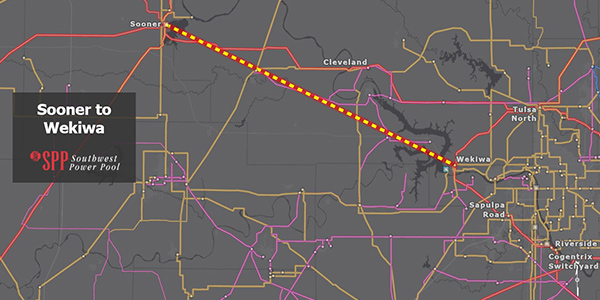SPP last week awarded its second competitive transmission project under FERC Order 1000, hopeful that it will succeed where the first one failed.
The Board of Directors on Oct. 27 approved an industry expert panel’s (IEP) recommendation to issue a notification to construct (NTC) to Transource Missouri, the panel’s “designated transmission owner,” for a 75-mile, 345-kV line in Oklahoma. The Sooner-Wekiwa project has a $66 million revenue requirement and an expected completion date of 2026.
The board approved Xcel Energy Southwest Transmission as the alternate builder.
The IEP evaluated 10 project bids under SPP’s competitive transmission owner selection process. Three of those bids came from Transource and occupied the top three spots in the panel’s intricate scoring matrix. The Transource bids were also the three most expensive, coming in between $66 million and $69 million. Projects submitted by other bidders ranged from $52.2 million to $64 million.
SPP awarded its first competitive project in 2016 to Mid-Kansas Electric, but the project was later canceled after load projections dropped. One stakeholder said at the time, “We went hunting for the project, we found it, we caged it — and we shot it.” (See SPP Cancels First Competitive Tx Project, Citing Falling Demand Projections.)
As was the case four years ago, the competitive project’s NTC went to an incumbent transmission provider, despite Order 1000’s requirement removing federal rights of first refusal. Transource Missouri is one of several subsidiaries of Transource Energy, a competitive transmission joint partnership between American Electric Power and Evergy. AEP’s Public Service Company of Oklahoma owns the Wekiwa substation’s end point west of Tulsa.
Oklahoma Gas & Electric owns the Sooner Power Plant at the other end of the project. In years past, the two utilities would likely have negotiated construction responsibilities.
The five-person IEP determined Transource’s winning proposal “best addressed a significant risk” to the project’s success, that being “the timely acquisition of rights of way.”
“This proposal also demonstrated significant capabilities and historical success in construction management and in the ability to operate and maintain a 345-kV transmission line,” the panel said in its final report.
Transource has completed three projects, in Missouri, Nebraska and West Virginia, and has a fourth under development, the Independence Energy Connection in Pennsylvania and Maryland.
SPP’s 2019 Integrated Transmission Planning assessment identified the Sooner-Wekiwa project as a potential competitive upgrade from among more than 1,600 proposed solutions submitted during the ITP process.
It estimated it would produce a 4.29 benefit-cost ratio under the Future 2 “emerging technologies” scenario, which assumed that electric vehicles, distributed generation, demand response and energy efficiency would increase energy growth rates, and that all coal and gas-fired generators over the age of 60 would retire. The assessment said the project will provide an alternate path for bulk power transfers to flow east to major SPP load centers, preventing flows from being diverted to the 138-kV system at Cleveland, Okla.
Requests for proposals were issued in early December 2019, requiring the IEP to be seated. The five-person panel, selected for its expertise in engineering design, project management construction, operations, rate analysis and finance, evaluated the project proposals in those categories. Five of the 10 proposals were submitted as detailed project proposals (DPPs), qualifying them for 100 incentive points each in the scoring. The other five were less detailed and did not qualify for the bonus points.
The winning proposal won a score of 877.9, topping the categories of Project Management and Operations and receiving the third highest point allocation for Engineering Design and fourth highest for Finance. Other projects scored from 517.8 to 871.9.
“I am very favorably impressed with the quality and thoroughness of the analysis of the submitted proposals,” Board Chair Larry Altenbaumer said.
Xcel’s Southwestern Public Service and Oklahoma cooperative Tri-County Electric were the only Members Committee representatives to vote against the recommendation.
“If you climb up to 35,000 feet, the present value revenue requirement for [Transource’s proposal] is 20% higher than the alternative proposal,” SPS President David Hudson said. “This is sort of showing the FERC 1000 process is actually costing SPP ratepayers more money. That isn’t even considering the cost of staff administering the 1,500 DPPs. What is this FERC Order 1000 process costing customers versus what it is saving them?”
The Advanced Power Alliance’s Steve Gaw agreed, saying a FERC 1000 policy discussion is “ripe.”
“It’s clear there are some issues in SPP’s Tariff that need to be thought through,” he said.
Golden Spread Electric Cooperative’s Michael Wise pointed out that the Strategic Planning Committee reviewed SPP’s competitive process following the Walkemeyer project’s selection four years ago. He said several improvements were made to the process.
“It might be necessary for the SPC to once again take up these issues,” he said.
“We would welcome a stakeholder process to look at improvements,” said IEP Chair Steve Strickland, a 35-year veteran of Entergy Arkansas. “This is only the second time we completed the process, and each time, we learned something new.”





